Acute Life Threatening Conditions: Urosepsis Case Study of Mr. Kirkman
VerifiedAdded on 2022/12/26
|7
|1575
|59
Report
AI Summary
This report analyzes a urosepsis case study of Mr. Kirkman, a 75-year-old male presenting with symptoms of a urinary tract infection that progressed to urosepsis. The report details the pathogenesis of urosepsis, explaining how a UTI can lead to a systemic inflammatory response syndrome. It explores the clinical manifestations, including elevated white blood cell count, high body temperature, tachycardia, respiratory alkalosis, and abnormal kidney function evidenced by elevated creatinine and urea levels. The report also discusses the nursing strategy of early intravenous antibiotic administration coupled with fluid resuscitation and the importance of ABG analysis, relating the results to the patient's condition, including the significance of pH, PaO2, PCO2, lactate, and bicarbonate levels. The report relates the findings of the case study to the patient's history of smoking and drinking and discusses the body's compensatory mechanisms and the impact on various systems, including the immune, endocrine, and autonomic systems.
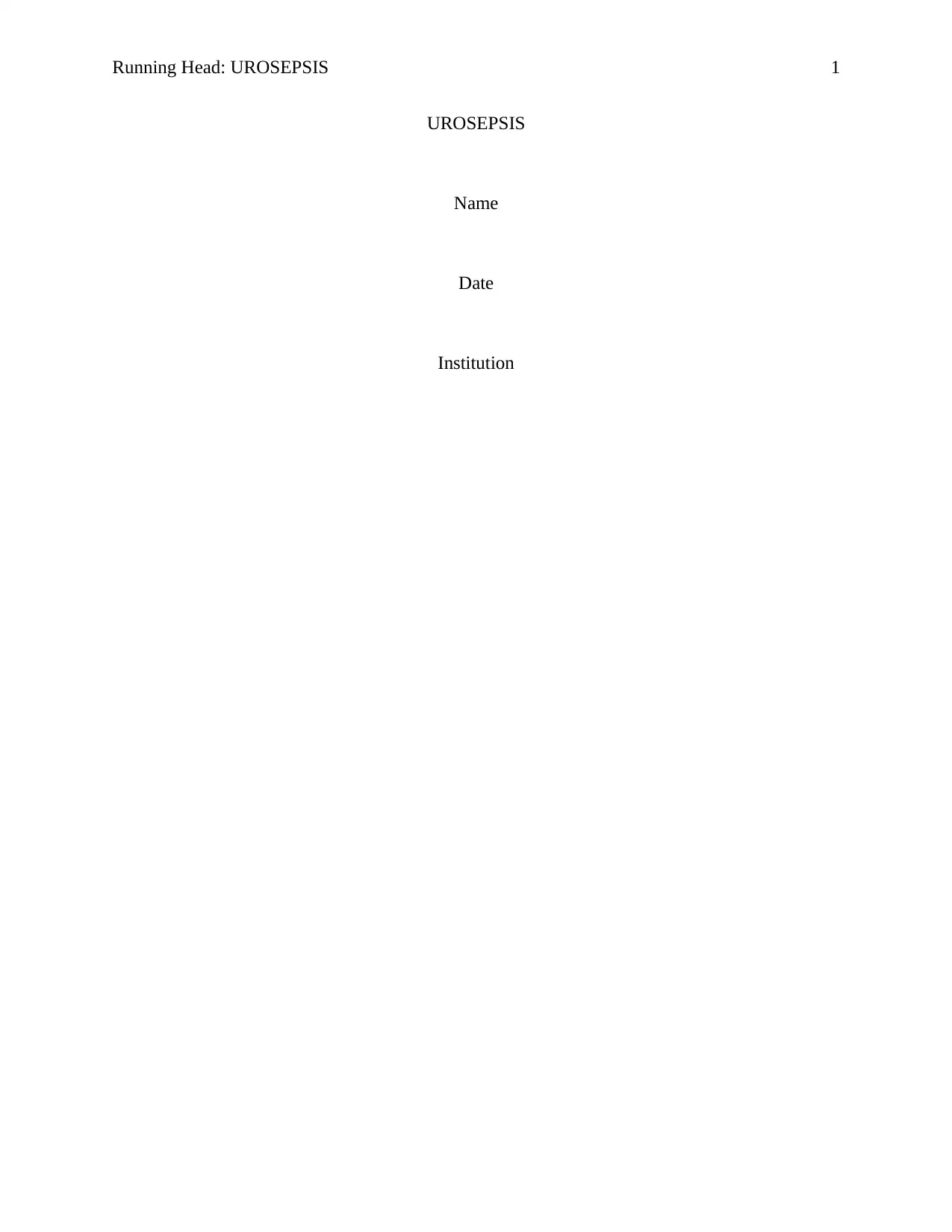
Running Head: UROSEPSIS 1
UROSEPSIS
Name
Date
Institution
UROSEPSIS
Name
Date
Institution
Paraphrase This Document
Need a fresh take? Get an instant paraphrase of this document with our AI Paraphraser
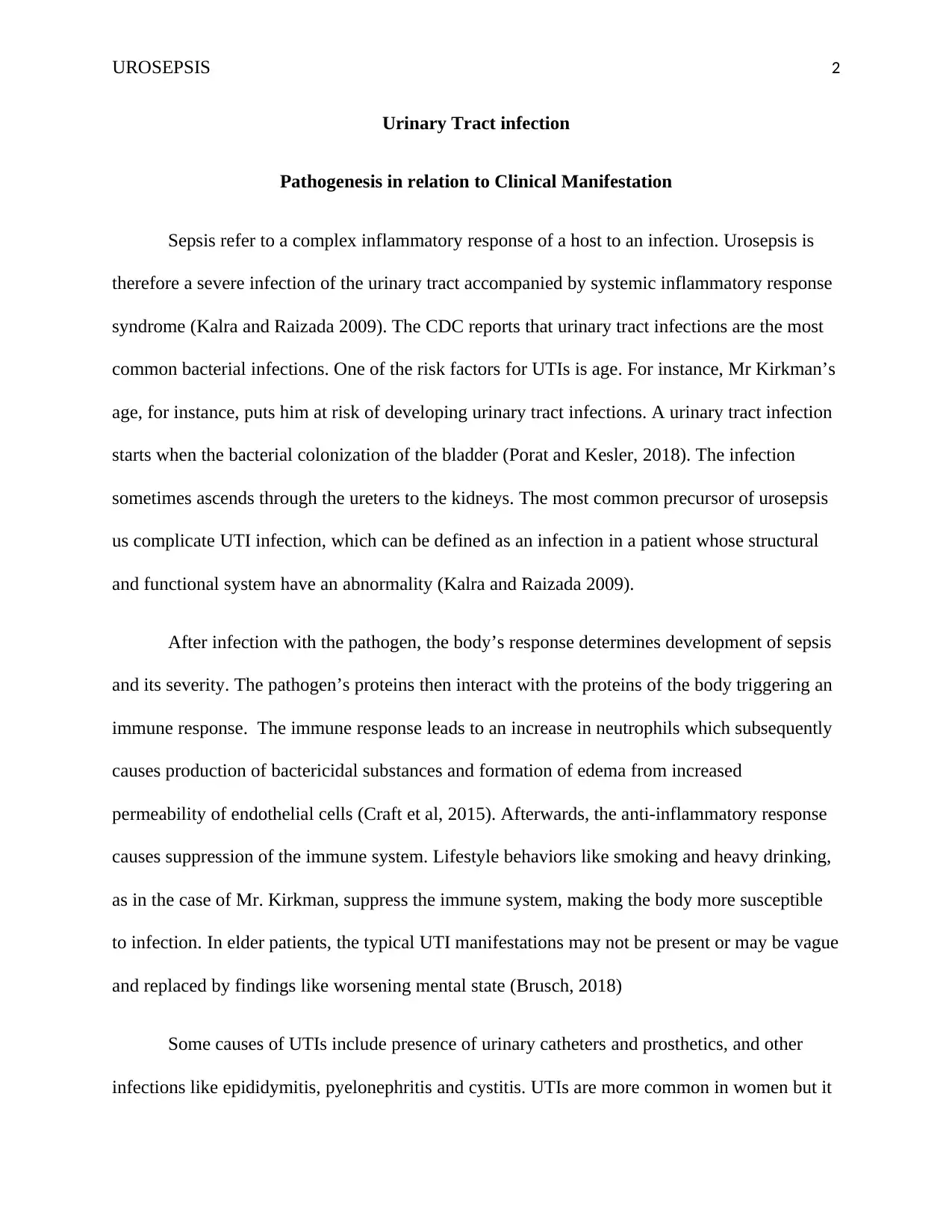
UROSEPSIS 2
Urinary Tract infection
Pathogenesis in relation to Clinical Manifestation
Sepsis refer to a complex inflammatory response of a host to an infection. Urosepsis is
therefore a severe infection of the urinary tract accompanied by systemic inflammatory response
syndrome (Kalra and Raizada 2009). The CDC reports that urinary tract infections are the most
common bacterial infections. One of the risk factors for UTIs is age. For instance, Mr Kirkman’s
age, for instance, puts him at risk of developing urinary tract infections. A urinary tract infection
starts when the bacterial colonization of the bladder (Porat and Kesler, 2018). The infection
sometimes ascends through the ureters to the kidneys. The most common precursor of urosepsis
us complicate UTI infection, which can be defined as an infection in a patient whose structural
and functional system have an abnormality (Kalra and Raizada 2009).
After infection with the pathogen, the body’s response determines development of sepsis
and its severity. The pathogen’s proteins then interact with the proteins of the body triggering an
immune response. The immune response leads to an increase in neutrophils which subsequently
causes production of bactericidal substances and formation of edema from increased
permeability of endothelial cells (Craft et al, 2015). Afterwards, the anti-inflammatory response
causes suppression of the immune system. Lifestyle behaviors like smoking and heavy drinking,
as in the case of Mr. Kirkman, suppress the immune system, making the body more susceptible
to infection. In elder patients, the typical UTI manifestations may not be present or may be vague
and replaced by findings like worsening mental state (Brusch, 2018)
Some causes of UTIs include presence of urinary catheters and prosthetics, and other
infections like epididymitis, pyelonephritis and cystitis. UTIs are more common in women but it
Urinary Tract infection
Pathogenesis in relation to Clinical Manifestation
Sepsis refer to a complex inflammatory response of a host to an infection. Urosepsis is
therefore a severe infection of the urinary tract accompanied by systemic inflammatory response
syndrome (Kalra and Raizada 2009). The CDC reports that urinary tract infections are the most
common bacterial infections. One of the risk factors for UTIs is age. For instance, Mr Kirkman’s
age, for instance, puts him at risk of developing urinary tract infections. A urinary tract infection
starts when the bacterial colonization of the bladder (Porat and Kesler, 2018). The infection
sometimes ascends through the ureters to the kidneys. The most common precursor of urosepsis
us complicate UTI infection, which can be defined as an infection in a patient whose structural
and functional system have an abnormality (Kalra and Raizada 2009).
After infection with the pathogen, the body’s response determines development of sepsis
and its severity. The pathogen’s proteins then interact with the proteins of the body triggering an
immune response. The immune response leads to an increase in neutrophils which subsequently
causes production of bactericidal substances and formation of edema from increased
permeability of endothelial cells (Craft et al, 2015). Afterwards, the anti-inflammatory response
causes suppression of the immune system. Lifestyle behaviors like smoking and heavy drinking,
as in the case of Mr. Kirkman, suppress the immune system, making the body more susceptible
to infection. In elder patients, the typical UTI manifestations may not be present or may be vague
and replaced by findings like worsening mental state (Brusch, 2018)
Some causes of UTIs include presence of urinary catheters and prosthetics, and other
infections like epididymitis, pyelonephritis and cystitis. UTIs are more common in women but it
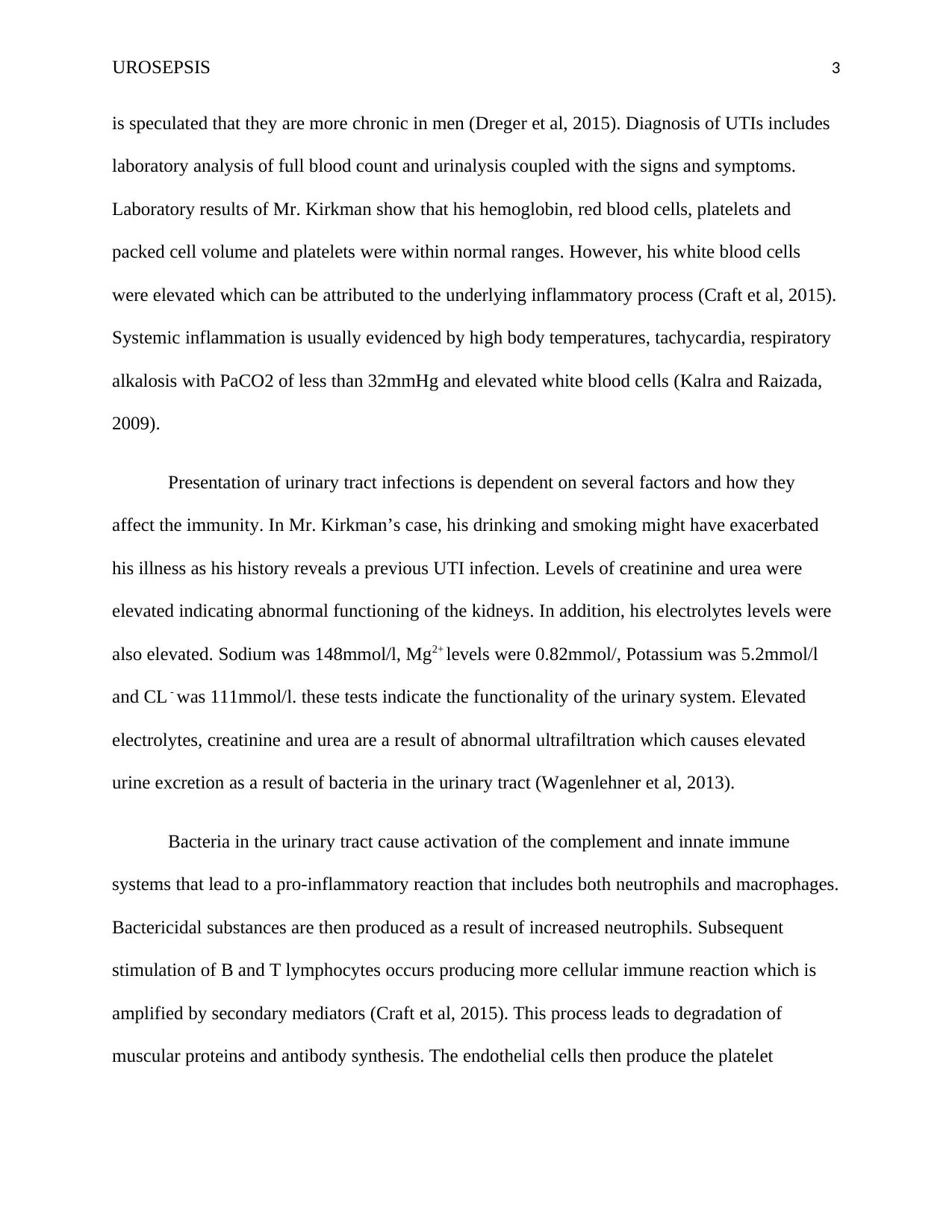
UROSEPSIS 3
is speculated that they are more chronic in men (Dreger et al, 2015). Diagnosis of UTIs includes
laboratory analysis of full blood count and urinalysis coupled with the signs and symptoms.
Laboratory results of Mr. Kirkman show that his hemoglobin, red blood cells, platelets and
packed cell volume and platelets were within normal ranges. However, his white blood cells
were elevated which can be attributed to the underlying inflammatory process (Craft et al, 2015).
Systemic inflammation is usually evidenced by high body temperatures, tachycardia, respiratory
alkalosis with PaCO2 of less than 32mmHg and elevated white blood cells (Kalra and Raizada,
2009).
Presentation of urinary tract infections is dependent on several factors and how they
affect the immunity. In Mr. Kirkman’s case, his drinking and smoking might have exacerbated
his illness as his history reveals a previous UTI infection. Levels of creatinine and urea were
elevated indicating abnormal functioning of the kidneys. In addition, his electrolytes levels were
also elevated. Sodium was 148mmol/l, Mg2+ levels were 0.82mmol/, Potassium was 5.2mmol/l
and CL - was 111mmol/l. these tests indicate the functionality of the urinary system. Elevated
electrolytes, creatinine and urea are a result of abnormal ultrafiltration which causes elevated
urine excretion as a result of bacteria in the urinary tract (Wagenlehner et al, 2013).
Bacteria in the urinary tract cause activation of the complement and innate immune
systems that lead to a pro-inflammatory reaction that includes both neutrophils and macrophages.
Bactericidal substances are then produced as a result of increased neutrophils. Subsequent
stimulation of B and T lymphocytes occurs producing more cellular immune reaction which is
amplified by secondary mediators (Craft et al, 2015). This process leads to degradation of
muscular proteins and antibody synthesis. The endothelial cells then produce the platelet
is speculated that they are more chronic in men (Dreger et al, 2015). Diagnosis of UTIs includes
laboratory analysis of full blood count and urinalysis coupled with the signs and symptoms.
Laboratory results of Mr. Kirkman show that his hemoglobin, red blood cells, platelets and
packed cell volume and platelets were within normal ranges. However, his white blood cells
were elevated which can be attributed to the underlying inflammatory process (Craft et al, 2015).
Systemic inflammation is usually evidenced by high body temperatures, tachycardia, respiratory
alkalosis with PaCO2 of less than 32mmHg and elevated white blood cells (Kalra and Raizada,
2009).
Presentation of urinary tract infections is dependent on several factors and how they
affect the immunity. In Mr. Kirkman’s case, his drinking and smoking might have exacerbated
his illness as his history reveals a previous UTI infection. Levels of creatinine and urea were
elevated indicating abnormal functioning of the kidneys. In addition, his electrolytes levels were
also elevated. Sodium was 148mmol/l, Mg2+ levels were 0.82mmol/, Potassium was 5.2mmol/l
and CL - was 111mmol/l. these tests indicate the functionality of the urinary system. Elevated
electrolytes, creatinine and urea are a result of abnormal ultrafiltration which causes elevated
urine excretion as a result of bacteria in the urinary tract (Wagenlehner et al, 2013).
Bacteria in the urinary tract cause activation of the complement and innate immune
systems that lead to a pro-inflammatory reaction that includes both neutrophils and macrophages.
Bactericidal substances are then produced as a result of increased neutrophils. Subsequent
stimulation of B and T lymphocytes occurs producing more cellular immune reaction which is
amplified by secondary mediators (Craft et al, 2015). This process leads to degradation of
muscular proteins and antibody synthesis. The endothelial cells then produce the platelet
⊘ This is a preview!⊘
Do you want full access?
Subscribe today to unlock all pages.

Trusted by 1+ million students worldwide
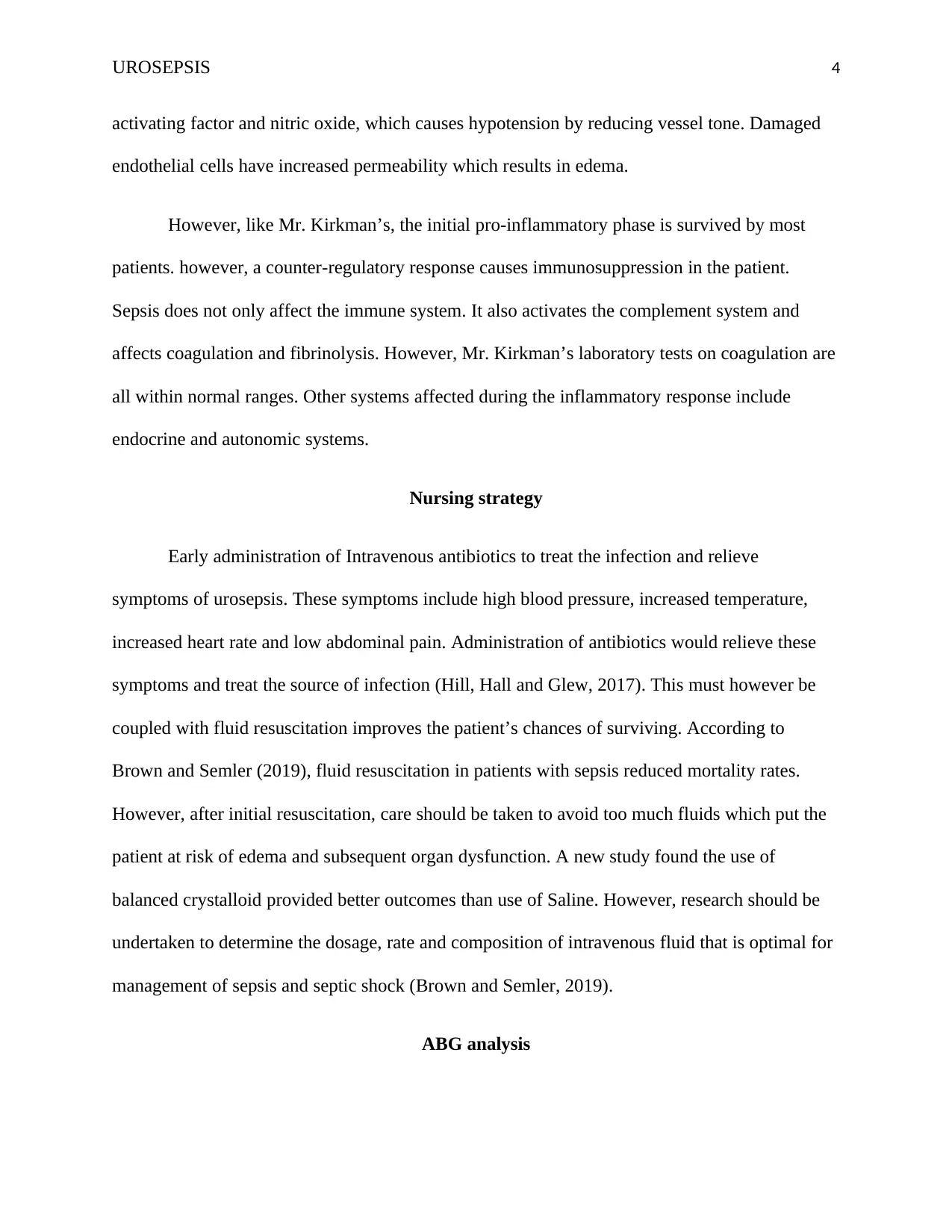
UROSEPSIS 4
activating factor and nitric oxide, which causes hypotension by reducing vessel tone. Damaged
endothelial cells have increased permeability which results in edema.
However, like Mr. Kirkman’s, the initial pro-inflammatory phase is survived by most
patients. however, a counter-regulatory response causes immunosuppression in the patient.
Sepsis does not only affect the immune system. It also activates the complement system and
affects coagulation and fibrinolysis. However, Mr. Kirkman’s laboratory tests on coagulation are
all within normal ranges. Other systems affected during the inflammatory response include
endocrine and autonomic systems.
Nursing strategy
Early administration of Intravenous antibiotics to treat the infection and relieve
symptoms of urosepsis. These symptoms include high blood pressure, increased temperature,
increased heart rate and low abdominal pain. Administration of antibiotics would relieve these
symptoms and treat the source of infection (Hill, Hall and Glew, 2017). This must however be
coupled with fluid resuscitation improves the patient’s chances of surviving. According to
Brown and Semler (2019), fluid resuscitation in patients with sepsis reduced mortality rates.
However, after initial resuscitation, care should be taken to avoid too much fluids which put the
patient at risk of edema and subsequent organ dysfunction. A new study found the use of
balanced crystalloid provided better outcomes than use of Saline. However, research should be
undertaken to determine the dosage, rate and composition of intravenous fluid that is optimal for
management of sepsis and septic shock (Brown and Semler, 2019).
ABG analysis
activating factor and nitric oxide, which causes hypotension by reducing vessel tone. Damaged
endothelial cells have increased permeability which results in edema.
However, like Mr. Kirkman’s, the initial pro-inflammatory phase is survived by most
patients. however, a counter-regulatory response causes immunosuppression in the patient.
Sepsis does not only affect the immune system. It also activates the complement system and
affects coagulation and fibrinolysis. However, Mr. Kirkman’s laboratory tests on coagulation are
all within normal ranges. Other systems affected during the inflammatory response include
endocrine and autonomic systems.
Nursing strategy
Early administration of Intravenous antibiotics to treat the infection and relieve
symptoms of urosepsis. These symptoms include high blood pressure, increased temperature,
increased heart rate and low abdominal pain. Administration of antibiotics would relieve these
symptoms and treat the source of infection (Hill, Hall and Glew, 2017). This must however be
coupled with fluid resuscitation improves the patient’s chances of surviving. According to
Brown and Semler (2019), fluid resuscitation in patients with sepsis reduced mortality rates.
However, after initial resuscitation, care should be taken to avoid too much fluids which put the
patient at risk of edema and subsequent organ dysfunction. A new study found the use of
balanced crystalloid provided better outcomes than use of Saline. However, research should be
undertaken to determine the dosage, rate and composition of intravenous fluid that is optimal for
management of sepsis and septic shock (Brown and Semler, 2019).
ABG analysis
Paraphrase This Document
Need a fresh take? Get an instant paraphrase of this document with our AI Paraphraser
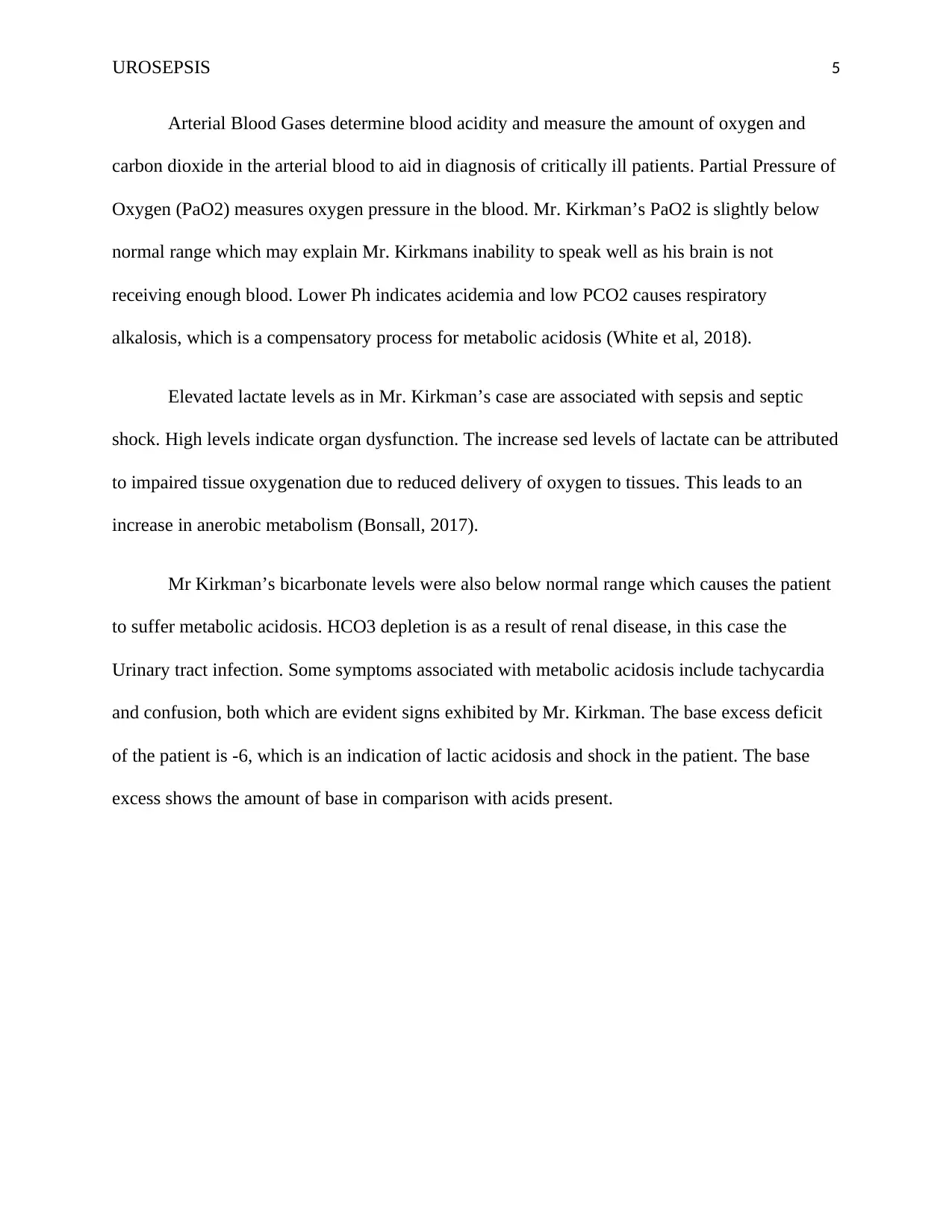
UROSEPSIS 5
Arterial Blood Gases determine blood acidity and measure the amount of oxygen and
carbon dioxide in the arterial blood to aid in diagnosis of critically ill patients. Partial Pressure of
Oxygen (PaO2) measures oxygen pressure in the blood. Mr. Kirkman’s PaO2 is slightly below
normal range which may explain Mr. Kirkmans inability to speak well as his brain is not
receiving enough blood. Lower Ph indicates acidemia and low PCO2 causes respiratory
alkalosis, which is a compensatory process for metabolic acidosis (White et al, 2018).
Elevated lactate levels as in Mr. Kirkman’s case are associated with sepsis and septic
shock. High levels indicate organ dysfunction. The increase sed levels of lactate can be attributed
to impaired tissue oxygenation due to reduced delivery of oxygen to tissues. This leads to an
increase in anerobic metabolism (Bonsall, 2017).
Mr Kirkman’s bicarbonate levels were also below normal range which causes the patient
to suffer metabolic acidosis. HCO3 depletion is as a result of renal disease, in this case the
Urinary tract infection. Some symptoms associated with metabolic acidosis include tachycardia
and confusion, both which are evident signs exhibited by Mr. Kirkman. The base excess deficit
of the patient is -6, which is an indication of lactic acidosis and shock in the patient. The base
excess shows the amount of base in comparison with acids present.
Arterial Blood Gases determine blood acidity and measure the amount of oxygen and
carbon dioxide in the arterial blood to aid in diagnosis of critically ill patients. Partial Pressure of
Oxygen (PaO2) measures oxygen pressure in the blood. Mr. Kirkman’s PaO2 is slightly below
normal range which may explain Mr. Kirkmans inability to speak well as his brain is not
receiving enough blood. Lower Ph indicates acidemia and low PCO2 causes respiratory
alkalosis, which is a compensatory process for metabolic acidosis (White et al, 2018).
Elevated lactate levels as in Mr. Kirkman’s case are associated with sepsis and septic
shock. High levels indicate organ dysfunction. The increase sed levels of lactate can be attributed
to impaired tissue oxygenation due to reduced delivery of oxygen to tissues. This leads to an
increase in anerobic metabolism (Bonsall, 2017).
Mr Kirkman’s bicarbonate levels were also below normal range which causes the patient
to suffer metabolic acidosis. HCO3 depletion is as a result of renal disease, in this case the
Urinary tract infection. Some symptoms associated with metabolic acidosis include tachycardia
and confusion, both which are evident signs exhibited by Mr. Kirkman. The base excess deficit
of the patient is -6, which is an indication of lactic acidosis and shock in the patient. The base
excess shows the amount of base in comparison with acids present.
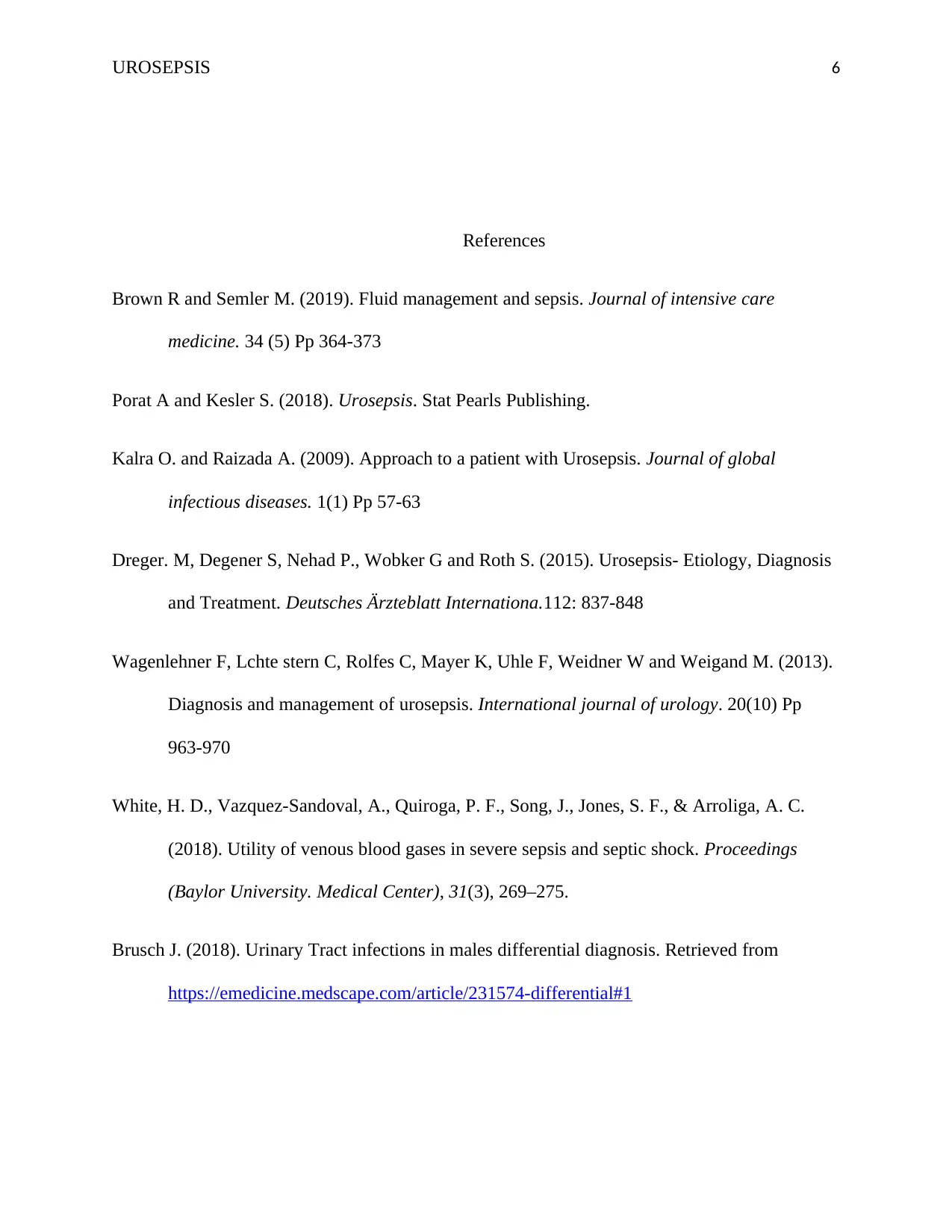
UROSEPSIS 6
References
Brown R and Semler M. (2019). Fluid management and sepsis. Journal of intensive care
medicine. 34 (5) Pp 364-373
Porat A and Kesler S. (2018). Urosepsis. Stat Pearls Publishing.
Kalra O. and Raizada A. (2009). Approach to a patient with Urosepsis. Journal of global
infectious diseases. 1(1) Pp 57-63
Dreger. M, Degener S, Nehad P., Wobker G and Roth S. (2015). Urosepsis- Etiology, Diagnosis
and Treatment. Deutsches Ärzteblatt Internationa.112: 837-848
Wagenlehner F, Lchte stern C, Rolfes C, Mayer K, Uhle F, Weidner W and Weigand M. (2013).
Diagnosis and management of urosepsis. International journal of urology. 20(10) Pp
963-970
White, H. D., Vazquez-Sandoval, A., Quiroga, P. F., Song, J., Jones, S. F., & Arroliga, A. C.
(2018). Utility of venous blood gases in severe sepsis and septic shock. Proceedings
(Baylor University. Medical Center), 31(3), 269–275.
Brusch J. (2018). Urinary Tract infections in males differential diagnosis. Retrieved from
https://emedicine.medscape.com/article/231574-differential#1
References
Brown R and Semler M. (2019). Fluid management and sepsis. Journal of intensive care
medicine. 34 (5) Pp 364-373
Porat A and Kesler S. (2018). Urosepsis. Stat Pearls Publishing.
Kalra O. and Raizada A. (2009). Approach to a patient with Urosepsis. Journal of global
infectious diseases. 1(1) Pp 57-63
Dreger. M, Degener S, Nehad P., Wobker G and Roth S. (2015). Urosepsis- Etiology, Diagnosis
and Treatment. Deutsches Ärzteblatt Internationa.112: 837-848
Wagenlehner F, Lchte stern C, Rolfes C, Mayer K, Uhle F, Weidner W and Weigand M. (2013).
Diagnosis and management of urosepsis. International journal of urology. 20(10) Pp
963-970
White, H. D., Vazquez-Sandoval, A., Quiroga, P. F., Song, J., Jones, S. F., & Arroliga, A. C.
(2018). Utility of venous blood gases in severe sepsis and septic shock. Proceedings
(Baylor University. Medical Center), 31(3), 269–275.
Brusch J. (2018). Urinary Tract infections in males differential diagnosis. Retrieved from
https://emedicine.medscape.com/article/231574-differential#1
⊘ This is a preview!⊘
Do you want full access?
Subscribe today to unlock all pages.

Trusted by 1+ million students worldwide
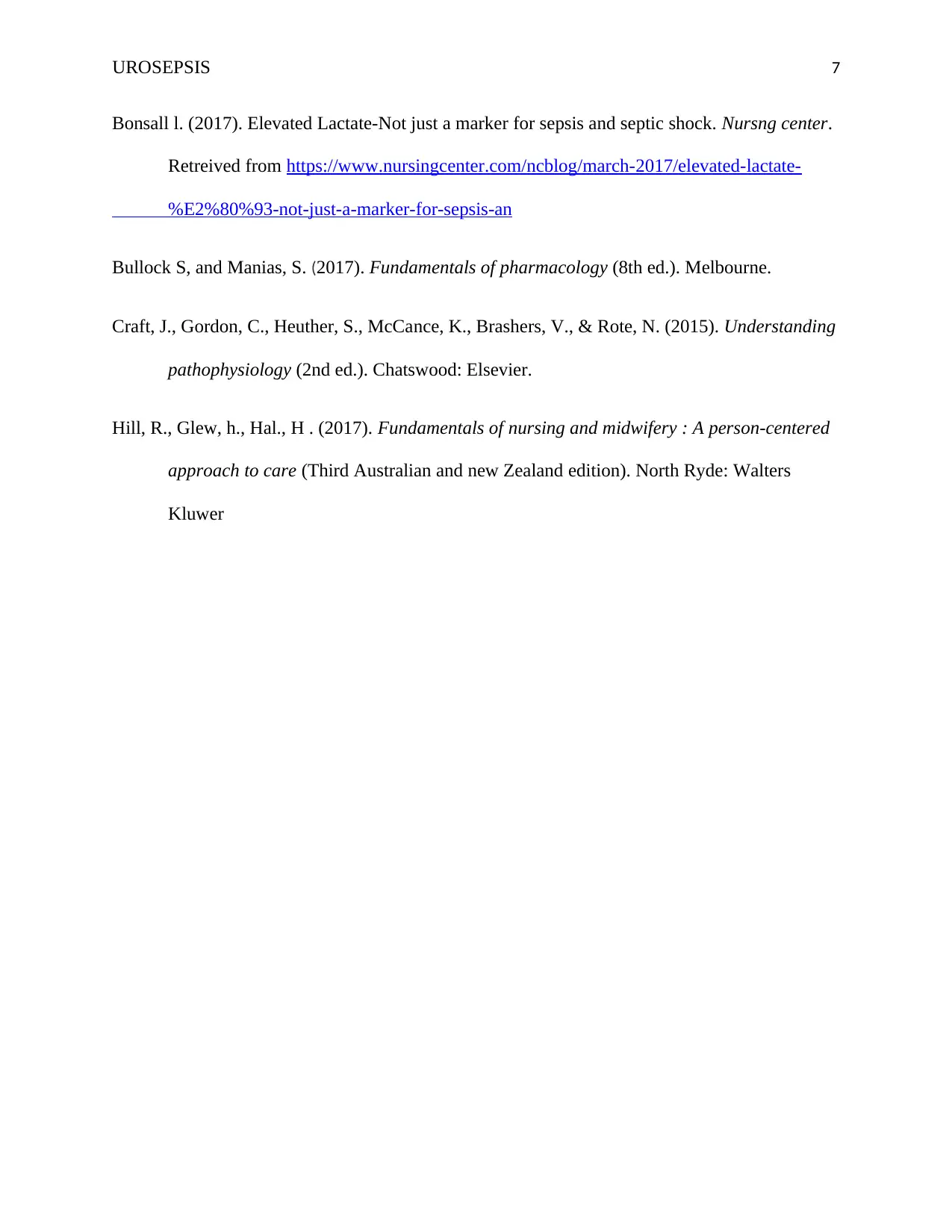
UROSEPSIS 7
Bonsall l. (2017). Elevated Lactate-Not just a marker for sepsis and septic shock. Nursng center.
Retreived from https://www.nursingcenter.com/ncblog/march-2017/elevated-lactate-
%E2%80%93-not-just-a-marker-for-sepsis-an
Bullock S, and Manias, S. (2017). Fundamentals of pharmacology (8th ed.). Melbourne.
Craft, J., Gordon, C., Heuther, S., McCance, K., Brashers, V., & Rote, N. (2015). Understanding
pathophysiology (2nd ed.). Chatswood: Elsevier.
Hill, R., Glew, h., Hal., H . (2017). Fundamentals of nursing and midwifery : A person-centered
approach to care (Third Australian and new Zealand edition). North Ryde: Walters
Kluwer
Bonsall l. (2017). Elevated Lactate-Not just a marker for sepsis and septic shock. Nursng center.
Retreived from https://www.nursingcenter.com/ncblog/march-2017/elevated-lactate-
%E2%80%93-not-just-a-marker-for-sepsis-an
Bullock S, and Manias, S. (2017). Fundamentals of pharmacology (8th ed.). Melbourne.
Craft, J., Gordon, C., Heuther, S., McCance, K., Brashers, V., & Rote, N. (2015). Understanding
pathophysiology (2nd ed.). Chatswood: Elsevier.
Hill, R., Glew, h., Hal., H . (2017). Fundamentals of nursing and midwifery : A person-centered
approach to care (Third Australian and new Zealand edition). North Ryde: Walters
Kluwer
1 out of 7
Related Documents
Your All-in-One AI-Powered Toolkit for Academic Success.
+13062052269
info@desklib.com
Available 24*7 on WhatsApp / Email
![[object Object]](/_next/static/media/star-bottom.7253800d.svg)
Unlock your academic potential
Copyright © 2020–2025 A2Z Services. All Rights Reserved. Developed and managed by ZUCOL.





